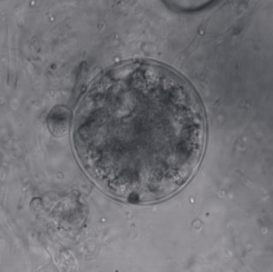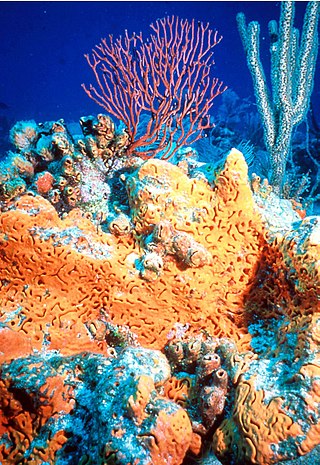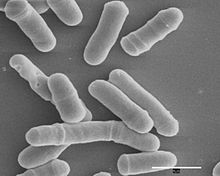
Chytridiomycota are a division of zoosporic organisms in the kingdom Fungi, informally known as chytrids. The name is derived from the Ancient Greek χυτρίδιον, meaning "little pot", describing the structure containing unreleased zoospores. Chytrids are one of the earliest diverging fungal lineages, and their membership in kingdom Fungi is demonstrated with chitin cell walls, a posterior whiplash flagellum, absorptive nutrition, use of glycogen as an energy storage compound, and synthesis of lysine by the α-amino adipic acid (AAA) pathway.

The opisthokonts are a broad group of eukaryotes, including both the animal and fungus kingdoms. The opisthokonts, previously called the "Fungi/Metazoa group", are generally recognized as a clade. Opisthokonts together with Apusomonadida and Breviata comprise the larger clade Obazoa.

Cristidiscoidea or Nucleariae is a proposed basal holomycota clade in which Fonticula and Nucleariida emerged, as sister of the fungi. Since it is close to the divergence between the main lineages of fungi and animals, the study of Cristidiscoidea can provide crucial information on the divergent lifestyles of these groups and the evolution of opisthokonts and slime mold multicellularity. The holomycota tree is following Tedersoo et al.

The Taphrinomycotina are one of three subdivisions constituting the Ascomycota and is more or less synonymous with the slightly older invalid name Archiascomycetes. Recent molecular studies suggest that the group is monophyletic and basal to the rest of the Ascomycota.

Pneumocystis jirovecii is a yeast-like fungus of the genus Pneumocystis. The causative organism of Pneumocystis pneumonia, it is an important human pathogen, particularly among immunocompromised hosts. Prior to its discovery as a human-specific pathogen, P. jirovecii was known as P. carinii.

Blastocladiomycota is one of the currently recognized phyla within the kingdom Fungi. Blastocladiomycota was originally the order Blastocladiales within the phylum Chytridiomycota until molecular and zoospore ultrastructural characters were used to demonstrate it was not monophyletic with Chytridiomycota. The order was first erected by Petersen for a single genus, Blastocladia, which was originally considered a member of the oomycetes. Accordingly, members of Blastocladiomycota are often referred to colloquially as "chytrids." However, some feel "chytrid" should refer only to members of Chytridiomycota. Thus, members of Blastocladiomyota are commonly called "blastoclads" by mycologists. Alternatively, members of Blastocladiomycota, Chytridiomycota, and Neocallimastigomycota lumped together as the zoosporic true fungi. Blastocladiomycota contains 5 families and approximately 12 genera. This early diverging branch of kingdom Fungi is the first to exhibit alternation of generations. As well, two (once) popular model organisms—Allomyces macrogynus and Blastocladiella emersonii—belong to this phylum.

Pucciniomycotina is a subdivision of fungus within the division Basidiomycota. The subdivision contains 10 classes, 21 orders, and 38 families. Over 8400 species of Pucciniomycotina have been described - more than 8% of all described fungi. The subdivision is considered a sister group to Ustilaginomycotina and Agaricomycotina, which may share the basal lineage of Basidiomycota, although this is uncertain due to low support for placement between the three groups. The group was known as Urediniomycetes until 2006, when it was elevated from a class to a subdivision and named after the largest order in the group, Pucciniales.

The Tremellomycetes are a class of dimorphic fungi in the Agaricomycotina. Some species have gelatinous basidiocarps or (microscopically) a sacculate parenthesome. There are six orders, 17 families, and 39 genera in the Tremellomycetes. Tremellomycetes include yeasts, dimorphic taxa, and species that form complex fruiting bodies. Tremellomycetes include some fungi that are human and animal pathogens in the genera Cryptococcus, Naganishia, Papiliotrema, and Trichosporon and some fungi that are cultivated for food in the genera Tremella and Naematelia.
Pathogenic fungi are fungi that cause disease in humans or other organisms. Although fungi are eukaryotic, many pathogenic fungi are microorganisms. Approximately 300 fungi are known to be pathogenic to humans; their study is called "medical mycology". Fungal infections kill more people than either tuberculosis or malaria—about 2 million people per year.

A fungus is any member of the group of eukaryotic organisms that includes microorganisms such as yeasts and molds, as well as the more familiar mushrooms. These organisms are classified as one of the traditional eukaryotic kingdoms, along with Animalia, Plantae and either Protista or Protozoa and Chromista.

Kickxellomycotina is a fungus grouping. In the subkingdom of Zoopagomyceta Benny, 2007.

The Filozoa are a monophyletic grouping within the Opisthokonta. They include animals and their nearest unicellular relatives.

Holomycota or Nucletmycea are a basal Opisthokont clade as sister of the Holozoa. It consists of the Cristidiscoidea and the kingdom Fungi. The position of nucleariids, unicellular free-living phagotrophic amoebae, as the earliest lineage of Holomycota suggests that animals and fungi independently acquired complex multicellularity from a common unicellular ancestor and that the osmotrophic lifestyle was originated later in the divergence of this eukaryotic lineage. Opisthosporidians is a recently proposed taxonomic group that includes aphelids, Microsporidia and Cryptomycota, three groups of endoparasites.

Glomerellales is an order of ascomycetous fungi within the subclass Hypocreomycetidae (Sordariomycetes). The order includes saprobes, endophytes and pathogens on plants, animals and other fungi with representatives found all over the world in varying habitats.

Choanozoa is a clade of opisthokont eukaryotes consisting of the choanoflagellates (Choanoflagellatea) and the animals. The sister-group relationship between the choanoflagellates and animals has important implications for the origin of the animals. The clade was identified in 2015 by Graham Budd and Sören Jensen, who used the name Apoikozoa. The 2018 revision of the classification first proposed by the International Society of Protistologists in 2012 recommends the use of the name Choanozoa.

Aphelida is a phylum of Fungi that appears to be the sister to true fungi.

Opisthosporidia is a superphylum of intracellular parasites with amoeboid vegetative stage, defined as a common group of eukaryotic groups Microsporidia, Cryptomycota and Aphelidea. They have been considered to represent a monophyletic lineage with shared ecological and structural features, being a sister clade of the Fungi. Together with the Fungi they represent a sister clade of the Cristidiscoidea, together forming the Holomycota.

Amastigomycota or Eufungi is a clade of fungi. It includes all fungi without flagella or centrioles, and with unstacked Golgi apparatus cisternae. Members of this clade are Dikarya and the traditional paraphyletic assemblage "Zygomycota", now divided into several monophyletic phyla.

Saccharomyceta is a clade of fungi containing Pezizomycotina and Saccharomycotina, or all Ascomycete fungi except Taphrinomycotina according to the 2007 fungal phylogeny "The Mycota: A Comprehensive Treatise on Fungi as Experimental Systems for Basic and Applied Research" and Tedersoo et al. 2018.

Orthomycotina is a clade of fungi containing Agaricomycotina and Ustilaginomycotina, or all Basidiomycete fungi except Pucciniomycotina according to the 2007 fungal phylogeny "The Mycota: A Comprehensive Treatise on Fungi as Experimental Systems for Basic and Applied Research" and Tedersoo et al. 2018.


















